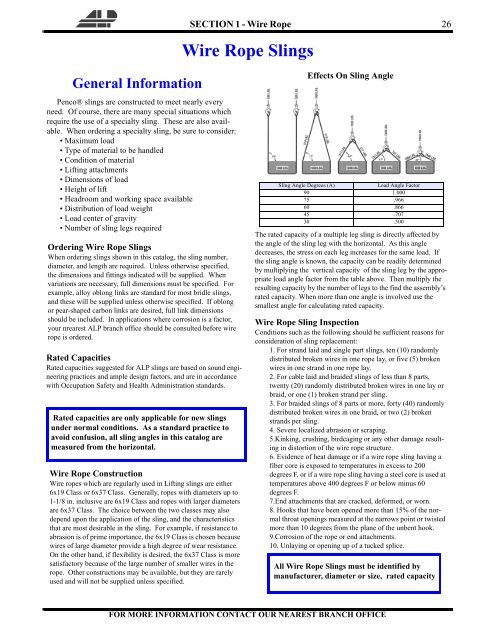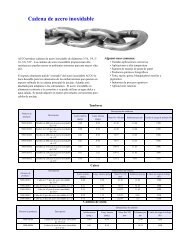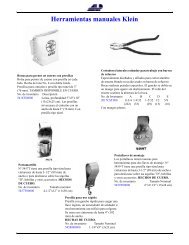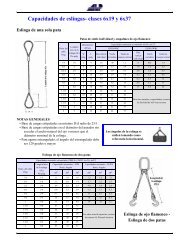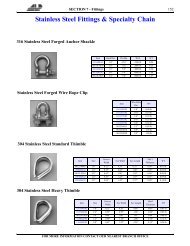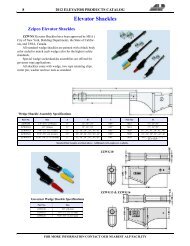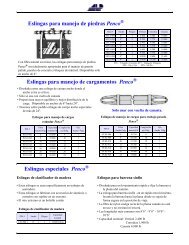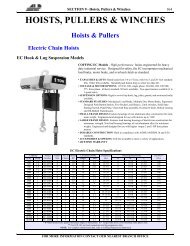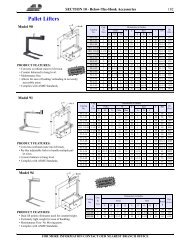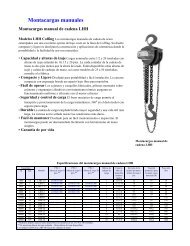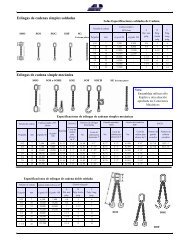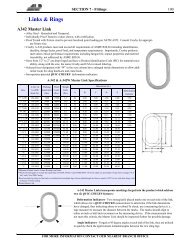General Products - ALP Industries Inc.
General Products - ALP Industries Inc.
General Products - ALP Industries Inc.
- No tags were found...
Create successful ePaper yourself
Turn your PDF publications into a flip-book with our unique Google optimized e-Paper software.
SECTION 1 - Wire Rope 26Wire Rope Slings<strong>General</strong> InformationPenco® slings are constructed to meet nearly everyneed. Of course, there are many special situations whichrequire the use of a specialty sling. These are also available.When ordering a specialty sling, be sure to consider:• Maximum load• Type of material to be handled• Condition of material• Lifting attachments• Dimensions of load• Height of lift• Headroom and working space available• Distribution of load weight• Load center of gravity• Number of sling legs requiredOrdering Wire Rope SlingsWhen ordering slings shown in this catalog, the sling number,diameter, and length are required. Unless otherwise specified,the dimensions and fittings indicated will be supplied. Whenvariations are necessary, full dimensions must be specified. Forexample, alloy oblong links are standard for most bridle slings,and these will be supplied unless otherwise specified. If oblongor pear-shaped carbon links are desired, full link dimensionsshould be included. In applications where corrosion is a factor,your nrearest <strong>ALP</strong> branch office should be consulted before wirerope is ordered.Rated CapacitiesRated capacities suggested for <strong>ALP</strong> slings are based on sound engineeringpractices and ample design factors, and are in accordancewith Occupation Safety and Health Administration standards.Rated capacities are only applicable for new slingsunder normal conditions. As a standard practice toavoid confusion, all sling angles in this catalog aremeasured from the horizontal.Wire Rope ConstructionWire ropes which are regularly used in Lifting slings are either6x19 Class or 6x37 Class. <strong>General</strong>ly, ropes with diameters up to1-1/8 in. inclusive are 6x19 Class and ropes with larger diametersare 6x37 Class. The choice between the two classes may alsodepend upon the application of the sling, and the characteristicsthat are most desirable in the sling. For example, if resistance toabrasion is of prime importance, the 6x19 Class is chosen becausewires of large diameter provide a high degree of wear resistance.On the other hand, if flexibility is desired, the 6x37 Class is moresatisfactory because of the large number of smaller wires in therope. Other constructions may be available, but they are rarelyused and will not be supplied unless specified.Effects On Sling AngleSling Angle Degrees (A)Load Angle Factor90 1.00075 .96660 .86645 .70730 .500The rated capacity of a multiple leg sling is directly affected bythe angle of the sling leg with the horizontal. As this angledecreases, the stress on each leg increases for the same load. Ifthe sling angle is known, the capacity can be readily determinedby multiplying the vertical capacity of the sling leg by the appropriateload angle factor from the table above. Then multiply theresulting capacity by the number of legs to the find the assembly’srated capacity. When more than one angle is involved use thesmallest angle for calculating rated capacity.Wire Rope Sling InspectionConditions such as the following should be sufficient reasons forconsideration of sling replacement:1. For strand laid and single part slings, ten (10) randomlydistributed broken wires in one rope lay, or five (5) brokenwires in one strand in one rope lay.2. For cable laid and braided slings of less than 8 parts,twenty (20) randomly distributed broken wires in one lay orbraid, or one (1) broken strand per sling.3. For braided slings of 8 parts or more, forty (40) randomlydistributed broken wires in one braid, or two (2) brokenstrands per sling.4. Severe localized abrasion or scraping.5.Kinking, crushing, birdcaging or any other damage resultingin distortion of the wire rope structure.6. Evidence of heat damage or if a wire rope sling having afiber core is exposed to temperatures in excess to 200degrees F, or if a wire rope sling having a steel core is used attemperatures above 400 degrees F or below minus 60degrees F.7.End attachments that are cracked, deformed, or worn.8. Hooks that have been opened more than 15% of the normalthroat openings measured at the narrows point or twistedmore than 10 degrees from the plane of the unbent hook.9.Corrosion of the rope or end attachments.10. Unlaying or opening up of a tucked splice.All Wire Rope Slings must be identified bymanufacturer, diameter or size, rated capacityFOR MORE INFORMATION CONTACT OUR NEAREST BRANCH OFFICE


